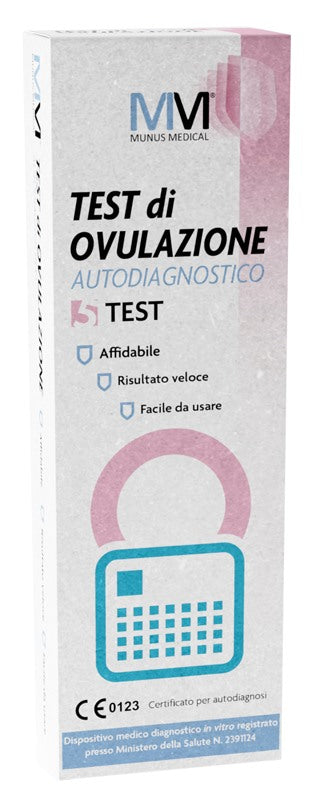MUNUS MEDICAL SELF-DIAGNOSTIC OVULATION TEST 5 PIECES MUNUS
Sold out
€9,90
Unit price
/
Unavailable
Tax included, shipping and discounts calculated at checkout.
MUNUS INTERNATIONAL | SKU:
986885123
Notify me when it's back in stock!
Write us your email, you will be notified when this product becomes available again!
MUNUS MEDICAL SELF-DIAGNOSTIC OVULATION TEST 5 PIECES MUNUS is backordered and will ship as soon as it is back in stock.
Shipping Costs and Times
Shipping Costs and Times
- Order fulfillment within 24 hours and delivery within the following 48/72 hours.
- Shipping cost: always free for orders over €49.90, otherwise it costs €4.99.
Payments
Payments
Payment information is processed securely. We do not store credit card information or have access to your credit card information.
Returns and Refunds
Returns and Refunds
You can return and receive a refund for the item within 30 days. See full policy here.

Do you need help?
Our customer service is here to help you!
- Contact us by phone, email or WhatsApp, from Monday to Friday, from 9:00 to 20:00 .
- For common questions, such as tracking your order or checking its fulfillment status, you can count on our artificial intelligence , available 24/7 .
We are always at your side to offer you fast and effective support!
Description
Description
MUNUS MEDICAL SELF-DIAGNOSTIC OVULATION TEST 5 PIECES MUNUS
MUNUS MEDICAL
OVULATION TEST
Description
Rapid chromatographic immunoassay for the qualitative detection of luteinizing hormone (LH) in urine to aid in the detection of ovulation.
The test uses a combination of antibodies, including the hLH monoclonal antibody, to selectively detect elevated levels of hLH. The urine sample moves laterally through the test due to capillary action.
In the presence of hLH, an immunological reaction occurs between hLH and the labeled anti-hLH antibodies, resulting in a colored test line. Depending on the hLH concentration, the test line becomes lighter or darker.
The other labeled antibodies are located on the control line. This reaction serves as a test for the correct use and functioning of the test strip.
How to use
Sample collection and preparation
Determine the optimal time to collect urine. For best results, collect urine at approximately the same time each day. Do not collect the first urine sample after waking up. Reduce fluid intake approximately 2 hours before collecting urine.
Record the date, day of your period, and time of urine collection.
Urine may be stored at room temperature for up to 8 hours or at 2-8°C for up to 24 hours. Do not freeze. For best results, test urine the same day it is collected. If refrigerated, allow urine to reach room temperature before testing.
Do not shake the container. If sediment forms at the bottom of the collection container, allow the sediment to settle. Use only urine from the top of the container.
When to start the test
Calculate when to start testing using the table.
First, determine the length of your menstrual cycle. Your menstrual cycle length is the number of days from the first day of your period (menstrual bleeding) to the last day before your next period begins. Next, determine how many days you should count forward after your period to begin testing. Find your menstrual cycle length on the first line of the table and read the corresponding number on the second line. This is the number of days after your period to begin testing.
If your menstrual cycle is shorter than 21 days or longer than 38 days, consult a doctor. If you do not know your cycle length, you can start testing 11 days after the first day of your period, as the average cycle length is 28 days.
First morning urine should not be used during LH testing.
For best results, you should test at the same time every day. You should reduce your fluid intake about 2 hours before the test. Perform 1 test per day for a period of time or until you detect the hLH surge.
Running the test
Determine the day you will start testing using the "When to Start Testing" table.
Bring the pouch to room temperature (15-30°C) before opening. Remove the midstream test from the sealed pouch and use within one hour.
Remove the cap and hold the midstream test by the capped thumb grip with the exposed absorbent tip pointing down directly into your urine stream for at least 15 seconds until completely wet. Do not urinate on the results window. If you prefer, urinate into a clean, dry container, then immerse only the absorbent tip of the midstream test in your urine for at least 15 seconds.
After removing the midstream test from the urine, immediately replace the cap on the absorbent tip, place the midstream test on a flat surface with the results window facing up, and then begin timing.
When the test starts running, you may notice a light colored stream moving across the results window.
Read the results after 3 minutes. If no result appears, wait one more minute. Do not read the result after 10 minutes.
Reading the results
POSITIVE: Two colored lines are visible and the line in the test zone (T) is equal to or darker than the line in the control zone (C). This indicates that ovulation will probably occur within the next 24-36 hours.
NEGATIVE: Two colored lines are visible, but the line in the test region (T) is lighter than the line in the control region (C), or there is no line in the test region (T). This indicates that no LH surge has been detected and that daily testing should be continued.
INVALID: The result is invalid if no colored line appears in the control region (C), even if a line appears in the test region (T). It would be advisable to repeat the procedure with a new test. If the problem persists, immediately stop using the test kit and contact your local distributor.
Warnings
For in vitro diagnostic use only. Not for internal use.
For single use only.
This test cannot be used as a form of birth control.
Do not reuse tests.
Test results should not be affected by painkillers, antibiotics, and other common medications. Medications containing hCG or LH may affect the test and should not be taken while using the Ovulation Test. Additionally, the test will not work properly for individuals who are pregnant, going through menopause, or taking birth control pills.
Keep out of reach of children.
Before performing the test, read all the information in the package leaflet.
Do not use after the expiry date printed on the package.
Do not use if pouch is torn or damaged.
Do not open the foil pouch until you are ready to begin testing.
The used test must be disposed of according to local regulations.
Conservation
Store in its original packaging at room temperature or in the refrigerator (2-30 °C). Avoid exposure to direct sunlight, moisture or heat. Do not freeze.
The test is stable until the expiration date printed on the sealed pouch. The test must remain in the sealed pouch until use. Do not use beyond the expiration date.
Validity with intact packaging: 24 months.
Format
The kit contains:
- Midstream testing;
- package leaflet.
Bibliography
1. Elkind-Hirsch, K; Goldzieher, JW; Gibbons, WE, and Besch, PK. Obstetrics and Gynecology, 67(3): 450-453, 1986.
Cod. MM-FLH-103H
Rapid chromatographic immunoassay for the qualitative detection of luteinizing hormone (LH) in urine to aid in the detection of ovulation.
The test uses a combination of antibodies, including the hLH monoclonal antibody, to selectively detect elevated levels of hLH. The urine sample moves laterally through the test due to capillary action.
In the presence of hLH, an immunological reaction occurs between hLH and the labeled anti-hLH antibodies, resulting in a colored test line. Depending on the hLH concentration, the test line becomes lighter or darker.
The other labeled antibodies are located on the control line. This reaction serves as a test for the correct use and functioning of the test strip.
How to use
Sample collection and preparation
Determine the optimal time to collect urine. For best results, collect urine at approximately the same time each day. Do not collect the first urine sample after waking up. Reduce fluid intake approximately 2 hours before collecting urine.
Record the date, day of your period, and time of urine collection.
Urine may be stored at room temperature for up to 8 hours or at 2-8°C for up to 24 hours. Do not freeze. For best results, test urine the same day it is collected. If refrigerated, allow urine to reach room temperature before testing.
Do not shake the container. If sediment forms at the bottom of the collection container, allow the sediment to settle. Use only urine from the top of the container.
When to start the test
Calculate when to start testing using the table.
First, determine the length of your menstrual cycle. Your menstrual cycle length is the number of days from the first day of your period (menstrual bleeding) to the last day before your next period begins. Next, determine how many days you should count forward after your period to begin testing. Find your menstrual cycle length on the first line of the table and read the corresponding number on the second line. This is the number of days after your period to begin testing.
If your menstrual cycle is shorter than 21 days or longer than 38 days, consult a doctor. If you do not know your cycle length, you can start testing 11 days after the first day of your period, as the average cycle length is 28 days.
First morning urine should not be used during LH testing.
For best results, you should test at the same time every day. You should reduce your fluid intake about 2 hours before the test. Perform 1 test per day for a period of time or until you detect the hLH surge.
| Menstrual cycle length | 21 | 22 | 23 | 24 | 25 | 26 | 27 | 28 | 29 | 30 | 31 | 32 | 33 | 34 | 35 | 36 | 37 | 38 |
| Days to count ahead | 6 | 6 | 7 | 7 | 8 | 9 | 10 | 11 | 12 | 13 | 14 | 15 | 16 | 17 | 18 | 19 | 20 | 21 |
Running the test
Determine the day you will start testing using the "When to Start Testing" table.
Bring the pouch to room temperature (15-30°C) before opening. Remove the midstream test from the sealed pouch and use within one hour.
Remove the cap and hold the midstream test by the capped thumb grip with the exposed absorbent tip pointing down directly into your urine stream for at least 15 seconds until completely wet. Do not urinate on the results window. If you prefer, urinate into a clean, dry container, then immerse only the absorbent tip of the midstream test in your urine for at least 15 seconds.
After removing the midstream test from the urine, immediately replace the cap on the absorbent tip, place the midstream test on a flat surface with the results window facing up, and then begin timing.
When the test starts running, you may notice a light colored stream moving across the results window.
Read the results after 3 minutes. If no result appears, wait one more minute. Do not read the result after 10 minutes.
Reading the results
POSITIVE: Two colored lines are visible and the line in the test zone (T) is equal to or darker than the line in the control zone (C). This indicates that ovulation will probably occur within the next 24-36 hours.
NEGATIVE: Two colored lines are visible, but the line in the test region (T) is lighter than the line in the control region (C), or there is no line in the test region (T). This indicates that no LH surge has been detected and that daily testing should be continued.
INVALID: The result is invalid if no colored line appears in the control region (C), even if a line appears in the test region (T). It would be advisable to repeat the procedure with a new test. If the problem persists, immediately stop using the test kit and contact your local distributor.
Warnings
For in vitro diagnostic use only. Not for internal use.
For single use only.
This test cannot be used as a form of birth control.
Do not reuse tests.
Test results should not be affected by painkillers, antibiotics, and other common medications. Medications containing hCG or LH may affect the test and should not be taken while using the Ovulation Test. Additionally, the test will not work properly for individuals who are pregnant, going through menopause, or taking birth control pills.
Keep out of reach of children.
Before performing the test, read all the information in the package leaflet.
Do not use after the expiry date printed on the package.
Do not use if pouch is torn or damaged.
Do not open the foil pouch until you are ready to begin testing.
The used test must be disposed of according to local regulations.
Conservation
Store in its original packaging at room temperature or in the refrigerator (2-30 °C). Avoid exposure to direct sunlight, moisture or heat. Do not freeze.
The test is stable until the expiration date printed on the sealed pouch. The test must remain in the sealed pouch until use. Do not use beyond the expiration date.
Validity with intact packaging: 24 months.
Format
The kit contains:
- Midstream testing;
- package leaflet.
Bibliography
1. Elkind-Hirsch, K; Goldzieher, JW; Gibbons, WE, and Besch, PK. Obstetrics and Gynecology, 67(3): 450-453, 1986.
Cod. MM-FLH-103H


